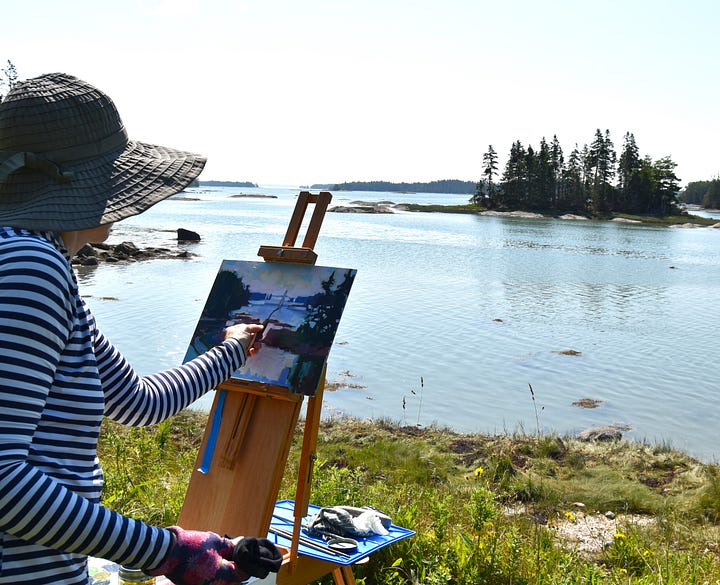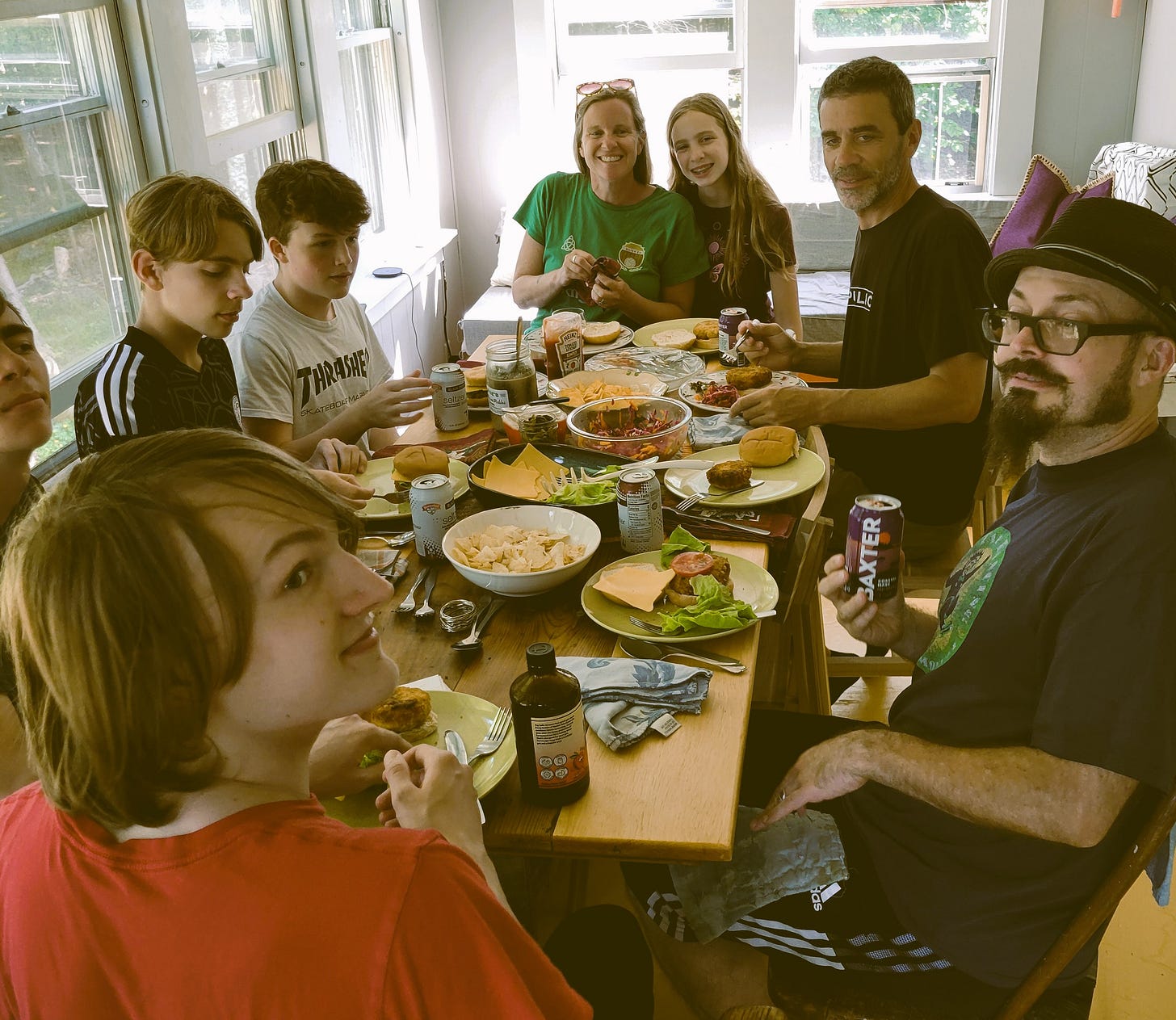Crafting Cod and Careers: Fish Burgers and Art Paths
Thinking of the business cycle in my art career and a recipe for fish burgers.


Cultivating an Art Career: A Cyclical Journey
In Western culture, we often perceive time as a linear progression—a straight line moving forward into the future or backward into the past. We plan for future events, imagining them as points on a timeline stretching into a fuzzy distance, with little certainty about how they will unfold. This perception of time shapes our approach to setting and achieving goals, including in the realm of art.
By contrast, Eastern cultures often view time as a circle—a recurring cycle without a distinct beginning or end. While cycles in Western culture may bring to mind the negative image of running in circles, it's more helpful to think of cycles as part of a life cycle or ecosystem, highlighting the importance of renewal and continued growth.
The Art of Planning for the Future
Recently, I've been reflecting on how my current success or challenges are directly linked to actions taken in the past. The reason I'm not selling as much artwork right now can be traced back to six months, a year, or even five years ago, when I didn't fully prepare for my present situation. This realization has shifted my focus: now, I'm actively putting things in place for potential exhibitions and/or sales six months or a year from now.
Most galleries’ calendars are planned out 18 months to three years in advance. Grant and residency cycles are often yearly. A gallery might accept your work today but not be able to fit it into their schedule for months or years. You might apply for a grant and not hear about the award status for six months.
Building Relationships and Marketing Strategically
To cultivate future success, I’m dedicating more time to building meaningful relationships with galleries, collectors, curators, and fellow artists. I’m also focusing on the marketing aspect of my career, striving to be more efficient and intentional than I was when I divided my time between art-making and my office job. Now, I have the time to devote to both my artwork and these connections. Additionally, I’m excited to support my artist friends in their goals by reconnecting with them and participating in a supportive community.
In business development, we often speak of a pursuit life cycle. This cycle consists of setting the groundwork for future results and then building upon those results. It’s a continual process. Back at the job-job, I worked with a team of people to pursue million-dollar contracts with large clients. We would ask questions before we pursued a project. We need to answer yes to all four questions.
Have we been in front of this client/partner in the past six months?
Do we know this client/partner’s motivators and issues?
How will this opportunity improve our position?
Do we want/are we able to do this work at this time?
As artists we don’t work in teams, but all by ourselves. Maybe we can adapt these questions to our art career?
Are we building relationships with galleries, collectors, curators, and our community?
Do we know if our work fits into this or that opportunity with galleries, collectors, grantors, or curators we have built relationships with?
How will this opportunity improve our career or future opportunities?
Do we want/are we able (financially/logistically) to do this work at this time?
The business development life cycle looks like the orange circle below.
How can the artist reimagine this for their own marketing purposes?
Identify where your art fits best in the market. Research galleries, grants, residencies, and collectors who appreciate and support the style and themes of your work. Find the right platforms and venues where your art can be showcased and appreciated.
Cultivate opportunities by building relationships. Put on your extroverted hat and get out of the studio and talk to people.
Evaluate the opportunities available to you. Not every opportunity is worth pursuing. Assess which avenues align with your art practice and goals.
Develop a plan to engage with your chosen opportunities. Tailor your plan to each specific opportunity. This might include:
- Creating a customized portfolio, body or work, webpage, or presentation.
- Setting clear goals and timelines for submitting applications or contacting galleries.
- Preparing documents and materials required for each opportunity.
- Developing a strategy to promote your work in line with each opportunity.
Strategically pursue the opportunities you've identified- reaching out, applying, and following up. It’s about actively engaging with the opportunities you've decided to pursue. But most importantly, MAKE THE WORK.
Refine your approach based on feedback and experience. Be prepared to adjust your strategies, learning from each experience and continuously improving your approach.
- Seek feedback (if possible) from gallery owners, curators, or grant committees on your submissions.
- Analyze the outcomes of your applications or pitches and identify areas for improvement.
- Continuously MAKE THE WORK and update your portfolio, website, and social media profiles.
Negotiate terms and finalize agreements. When an opportunity moves forward, it’s important to negotiate terms that are fair and beneficial for both you and the other party. This phase ensures that all parties are aligned and that the opportunity is set up for success.
- Discuss contract terms, including payment, delivery, and schedules.
- Clarify expectations regarding marketing, promotion, and responsibilities.
- Ensure all agreements and deadlines are documented.
Deliver your work and maintain ongoing engagement. Fulfill your commitments, such as creating and delivering artworks, participating in exhibitions, or attending residency programs. It’s also about continuing to build and nurture relationships for future opportunities.
- Meet all deadlines and deliverables.
- Communicate regularly with your contacts, providing updates on your progress.
- Participate actively in any exhibitions or programs, making the most of the opportunity.
- Continue to build your network and seek new opportunities within your existing relationships.
- Express gratitude- thank the galleries, curators, collectors, residency administrators and grantors.
Phew, that is a lot of work for one person!
Embracing the Cycle with Patience and Purpose
Instead of doing this for a job-job, I am now able to do this for myself. I am working through this cycle with purpose rather than the frantic energy often associated with the "hamster wheel." I remind myself that the preparation I'm doing now is laying the groundwork for future opportunities, even if it means facing financial challenges in the short term or if some of this work is not fruitful in the long term.
The concept of time as a circle rather than a straight line offers a valuable framework for viewing our artistic endeavors. By recognizing the cyclical nature of our efforts, we can approach our art careers with a concrete pattern of work and a sense of ongoing growth. Each step we take builds upon the last.
What are your thoughts on seeing art goals as a circle instead of a time line?
Fish Burgers with Tartar Sauce

Makes: 4 to 5 burgers
Ingredients
Fish Burgers:
1 pound cod or haddock (fresh or frozen)
1 teaspoon salt
1/2 teaspoon paprika
5 scallions, chopped
1 fist-sized boiled potato, mashed (or leftover mashed potatoes)
1/2 teaspoon garlic powder or fresh minced garlic (or 1 chopped garlic scape, if available)
1 egg
1/4 cup Panko crumbs
Flour and Panko crumbs for dredging
Tartar Sauce:
1/2 cup mayonnaise
1-2 tablespoons Greek yogurt
2 tablespoons green onions, chopped
1 dill pickle, chopped
2 teaspoons Dijon mustard
1 cup red cabbage, thinly sliced
1 tablespoon vinegar or pickle juice
1 tablespoon olive oil
Salt to taste
Instructions
1. Make the Tartar Sauce:
In a bowl, mix mayonnaise, Greek yogurt, green onions, dill pickle, and Dijon mustard.
Refrigerate until ready to serve.
2. Prepare the Fish Burgers:
Cut the fish into 2-inch chunks.
In a food processor (or using a grinder), combine fish, salt, paprika, scallions, mashed potato, garlic powder (or scapes), egg, and Panko crumbs. Pulse until the mixture has a consistent texture.
No food processor? Mince or grind the fish finely and mix with the rest of the ingredients in a bowl.
Shape the mixture into 4 to 5 balls, then flatten into patties.
Dredge the patties in a mixture of flour and Panko crumbs.
3. Cook the Fish Burgers:
Heat a thin layer of oil in a large skillet over medium-high heat.
When the oil is spitting hot, gently place the fish patties in the pan.
Cook for about 5 minutes on each side until golden brown and cooked through.
4. Serve:
On a hamburger bun, place a fish patty, then add tartar sauce, cheddar cheese, lettuce, and tomato slices.
Enjoy your homemade fish burgers!






The cover of “The Little Island” by Margaret Wise Brown (whom I adore) immediately popped into my head when I saw image with this post. Just wanted to share :-)
Great post, Kate. I'm with you on the circle of time approach to things. Your insight with planning, implementing and follow-through is pretty thorough and intentional. I'm at a place now where I see how my present position is totally due to things I did or, more appropriately, didn't do over the past year or three.. Working through it and trying to set myself up for the next few months to a year.
Thanks for sharing your breakdown of the way you're planning things out. I'm familiar with most of it, but there's always room to rethink some things.
I like the way you share recipes, too.